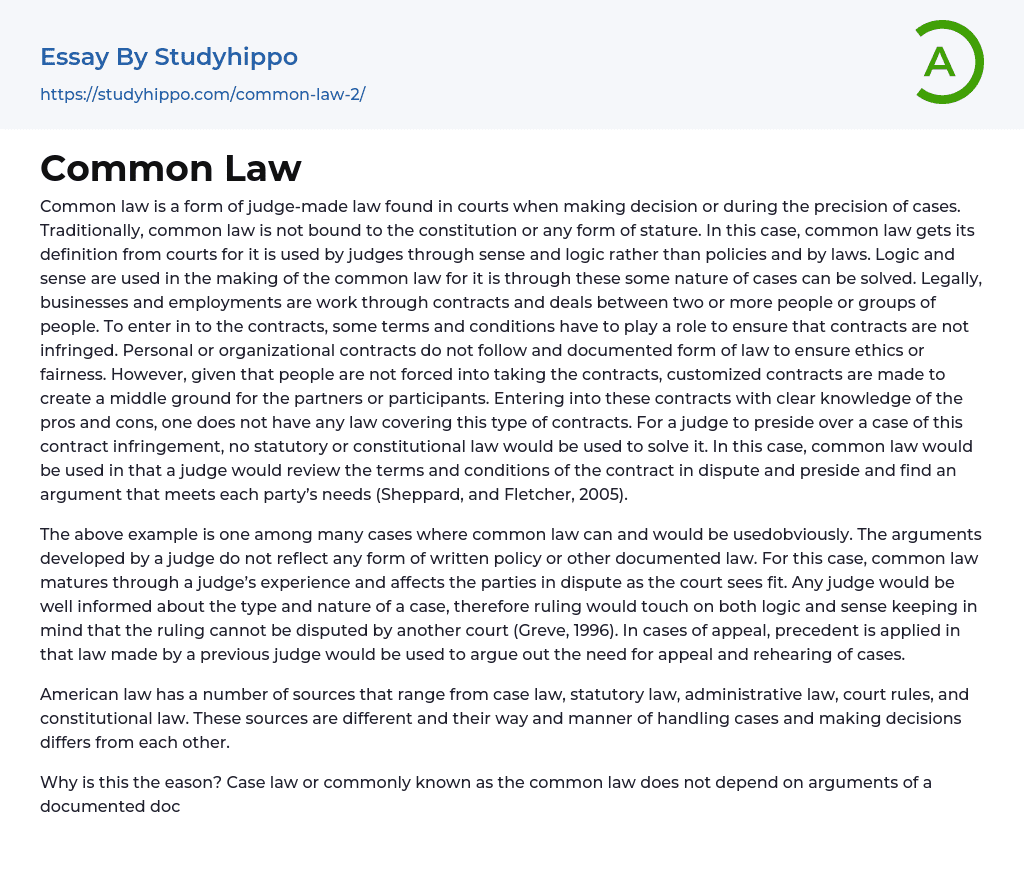Common law, which is judge-made law used in courts to resolve cases and make decisions, is not bound by the constitution or any statute. Instead, it is defined by courts and applied by judges based on sense and logic rather than policies and laws. Sense and logic are employed to solve various types of cases.
In the legal realm, contracts and agreements between parties govern businesses and employment relationships. These contracts have specific terms and conditions to ensure they are not violated. Unlike predetermined set of laws for fairness and ethics, personal or organizational contracts are customized when voluntarily entered into by all parties involved.
Since there are no specific laws governing these contracts, if a dispute arises, a judge would rely on common law principles. The judge would examine the terms and conditions of the disputed contract t
...o determine an argument that satisfies each party's needs. This example illustrates how common law can be utilized in various cases because the arguments presented by a judge do not rely on written policies or documented laws.
In this particular case, common law is developed based on the experience of the judge and applied by the court to resolve disputes. The judge considers both logical and sensible factors when making a ruling that cannot be appealed by another court (Sheppard & Fletcher, 2005).The need for reviewing and rehearing cases in appeals based on precedent is argued by Greve (1996). American law encompasses various sources such as case law, statutory law, administrative law, court rules, and constitutional law. These sources employ different methods to handle cases and make decisions. Common law relies on the court's or judge's reasoning rather than
documented doctrine. For example, if a farmer is accused of possessing a firearm, they can present a certificate of ownership to obtain bail release. However, if the firearm in question is a military rifle, this evidence would not be sufficient. In such situations, the judge would question why a farmer would possess such a weapon and ultimately make the final decision based on these circumstances.
Statutory law governs municipal laws or ordinances within states but may be invalidated if it conflicts with federal law. While each state has its own set of laws regarding certain behaviors and activities, federal laws take precedence and universally protect certain activities – like the freedom to choose religion. The legislative branch has limited authority to punish criminal activities and cannot penalize individuals based on their religious choices as outlined in the first amendment to the federal constitution.Administrative law is a branch of American law that regulates government actions at the state level and oversees government procedures within each state. In Indiana, the administrative branch provides assistance to those in need, while the regulatory board governs the distribution of medical supplies to healthcare centers. Both administrative law and American Law contribute to the overall legal system.
Legislative decisions, called court rules, are an essential part of this system as they fill in gaps left by legislatures. Created by courts themselves, these court rules must be voted on or enacted by each state's highest courts to apply. Supreme Court-established court rules require approval or nullification from Congress. If not nullified, these court rules become legally binding nationwide.
Court rules play a crucial role in organizing the court system, dictating aspects like timing of filing
cases and limits on length of memoranda and briefs. Though not considered laws themselves, these rules significantly impact case outcomes and serve as an important source for American Law.
The United States holds its Constitution and Bill of Rights in high regard as fundamental doctrines of law. It is important to note that no rule or law can contradict these revered documents.The constitution serves as a fundamental source of American law, providing guidelines for state laws and constitutions (Earl Warren Legal Institute and Frank, 1969). Precedent is crucial in judicial decision-making as it applies common law and upholds previous court rulings, regardless of their age. This judge-made law remains valid and useful in cases with similar arguments or interventions, promoting consistency and firmness in court decisions. It ensures fairness and justice without favoritism towards any group (Greve, 1996).
In the realm of common law courts, equity courts develop and grant remedies. In modern laws, both legal remedies and equity remedies are combined, allowing the same court to issue both types of provisions. Legal remedies relate to decisions made in favor of claimants or considering specific rights (Earl Warren Legal Institute and Frank, 1969), while equity remedies involve injunctions and specific performances issued to defendants.
Injunctions have the power to compel individuals to either perform an action or abstain from it. On the other hand, specific performance requires someone to fulfill a particular task such as transferring goods or land to the person making the claim.
- Agreement essays
- Business Law essays
- Common Law essays
- Community Policing essays
- Constitution essays
- Consumer Protection essays
- Contract essays
- Contract Law essays
- Copyright Infringement essays
- Court essays
- Crime essays
- Criminal Law essays
- Employment Law essays
- Family Law essays
- Injustice essays
- Judge essays
- Jury essays
- Justice essays
- Lawsuit essays
- Lawyer essays
- Marijuana Legalization essays
- Ownership essays
- Police essays
- Property essays
- Protection essays
- Security essays
- Tort Law essays
- Treaty essays
- United States Constitution essays
- War on Drugs essays




